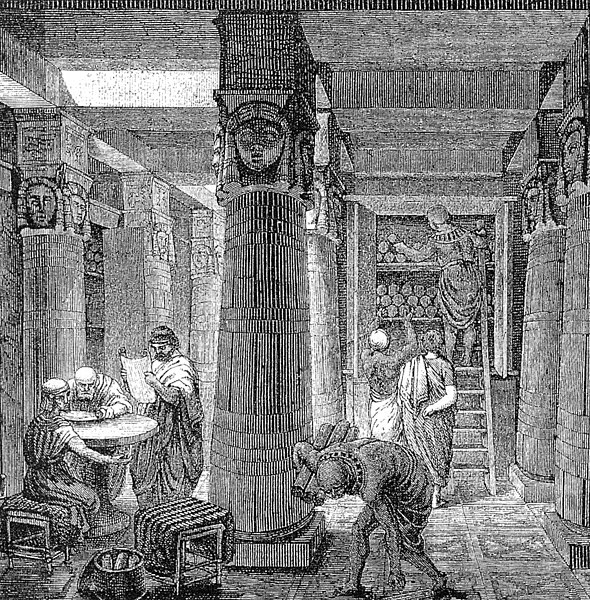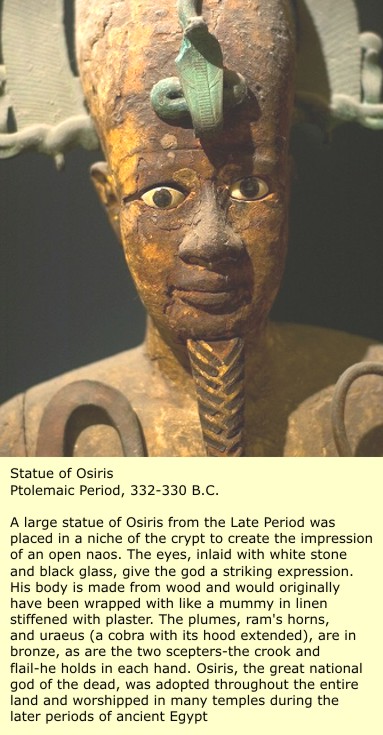The Origins of the Bible Pt. OneA Story by MaxillioThe Origins of the Bible Pt. OneWelcome, Villains. We’re about to free your mind. In typical Kaperville style, I’m only going to give you facts. Let’s go. Our story begins with Alexander the so-called Great’s conquest of Egypt. He wanted to be proclaimed a god so, he went, with his soldiers, to the Oracle of Amun in the western Egypt to a place called the Siwa Oasis.  Picture taken from Shaly Island in Siwa, Egypt. Siwa Oasis can be seen in the background. He asked the oracle, “Am I the Son of Amun” The Oracle said, “No”. He put a sword the the Oracle’s neck, and the Oracle said, “Yes”.  This is a rare painting of Alexander at the Temple of Ptah From there, Alexander went to the Temple of Ptah in Memphis to get the priest there to proclaim him as the “Son of God”. Some of the priest refused, however, he still had coins minted depicting himself as the Son of Amun.  Zeus Ammon. Roman copy of a Greek original from the late 5th century BC. The Greeks of the lower Nile Delta and Cyrenaica combined features of supreme god Zeus with features of the Egyptian god Ammon-Ra  This is the coin that Alexander the so- called Great minted after he forced the Oracle of Amun to declare he was the son of Amun. Despite his attempts to portray himself as the Son of Amun, the priest, as well as the rest of the Egyptian people NEVER accepted him as the Son of Amun. In 331 BC, he founded the city of Alexandria. Now, what is important about this is, Alexandria was built on reclaimed marshland. It was not a part of Egypt. It was “ad-hoc” Egypt. It was an addition. Sort of like building a deck onto your house. Alexandria became the center of Hellenistic (Greek) culture in Egypt. Alexandria was also one of the first segregated cities. The Greeks were the first class citizens and the Egyptians were on the bottom. Shortly after Alexandria was completed, Alexander left Egypt and never returned. After is death, one of his generals, Ptolemy Lagides took over as ruler of Egypt from 323�"283 BC and became known as Ptolemy Soter (The Savior).  Bust of Ptolemy I Soter, king of Egypt (305 BC�"282 BC) and founder of the Ptolemaic dynasty. Ptolemy wanted to succeed where Alexander had failed. The Greeks who came to Egypt soon fell in love with every thing Egyptian. They adopted the Egyptian style of dress, culture, religion…and that’s where the problems began. The Greeks loved every thing about Egypt except for the black people in Egypt, and the worshiping of black deities. No matter how much they immersed themselves into Egyptian culture there was one thing they did not have. The same appearance as the god they worshiped.
Look at that nose. If you were a Greek, would you have any doubt about the ethnicity of that god? It was the same ethnicity as their servants and housemaids. The Greeks could dress Egyptian. They could go to the temples of the Egyptians, but a black skinned god was a constant reminder to them that they were not Egyptians (kinda like hip-hop, and black culture, today). No matter how much they imitated the Egyptians, they could not be truly Egyptian. This becomes a problem when have just conquered a nation and are now praying to and worshiping a god that looks like the people you conquered. Can’t have that, can we? Enter the Solution. Ptolemy I ordered the Egyptian priest to make statues in his image for the Greeks to worship, and to have them placed in the temples along side the original statues, so everyone could worship together. This was to be the first attempt at “integration”. The priest said, “No”. Ptolemy ordered his army to shut down all the temples along the Nile River, and to confiscate all sacred Kemetic text. He then had the text brought to Alexandria. This was the first time, in history, all Egyptian knowledge was gathered in one place. We all know knowledge is power. At this point, Ptolemy had all the knowledge, and thus the power. Ptolemy wanted to find a deity that would win the reverence of both groups, despite the protest of the Egyptian priests. Alexander had attempted to use Amun for this purpose, but Amun was more prominent in Upper Egypt, and was not so popular with those in Lower Egypt, where the Greeks had stronger influence. Nevertheless, the Greeks had little respect for “animal-headed figures”, and so a Greek statue was chosen as the idol, and proclaimed as anthropomorphic equivalent of the popular Apis. It was named Aser-hapi (i.e. Osiris-Apis), which became Serapis, and was said to be Osiris in full, rather than just his Ka (Spirit).  Bust of Serapis. Roman copy after a Greek original from the 4th century BC, stored in the Serapaeum of Alexandria….kinda looks like…. He had the sacred texts stored in the Temple of Ptah, because those where the same priest who capitulated to the wishes of Alexander. If you like, you can say these were the first documented “Uncle Toms” in black history. When Ptolemy Soter died, Ptolemy Philadelphus took over and ruled Egypt from 283 BC to 246 BC. Ptolemy Philadelphus took the scrolls that his father had stolen and housed them in a temple he built for the god his father created, Serapis, called theSerapeum.  Pompey’s Pillar” (erected by Diocletian) above the original site of the Alexandrian Serapeum After he built that temple, he built another one over it called the Mouseion at Alexandria  The Mouseion at Alexandria was the location of the library of Alexander. Notice the scrolls of stolen Egyptian text being studied by Greeks From Wikipedia
More than 1,000 scholars lived in the Mouseion at a given time. Staff members and scholars were salaried by the Mouseion and paid no taxes. They also received free meals, free room and board, and free servants. The Mouseion was administered by a priest appointed by Ptolemy II. Greeks were in Egypt learning and studying the accumulated wisdom of African civilization, including Plato, who I was told was one of the wisest people in western history. He was merely a student of the Africans. The “university” was headed by an Egyptian priest appointed by Ptolemy II. He could be considered the second documented “Uncle Tom” in history. After the Greeks learned everything they could from the Egyptians, they set fire to the scrolls to destroy all evidence of Egyptian knowledge. This is known in history as the burning of the Library of Alexandria.
Before the library and the text were destroyed Ptolemy Philodelphius realized that there was not a copy of the ancient Kemetic/ Egyptian text for the Greek Egyptians to read. He commissioned 72 NON-EGYPTIAN scholars to translate the ancient scrolls and compile them into one book for the Greeks. This book was called the Septuagint (meaning seventy, or LXX). This is the book from which we get the Pentateuch, the Torah, and the Old Testament. The Bible is nothing more than a Greek regurgitation of misunderstood, and plagiarized Kemetic stories. The Bible is whitewashed black history. Part 2 coming soon. Thank you and good night. © 2015 Maxillio |
Stats |



 Flag Writing
Flag Writing